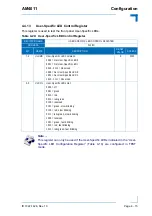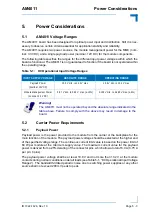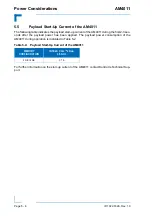
AM4011
Thermal Considerations
ID 1022-1626, Rev. 1.0
Page 6 - 5
P R E L I M I N A R Y
6.1.2
Board Thermal Monitoring
The AM4011 includes four board temperature sensors distributed over the complete board to
measure the board temperature and regulate the board's power consumption (see Figure 6-1).
The board temperature sensors accessible via the Module Management Controller.
The AM4011 uses the following board temperature sensors:
•
Inlet board temperature sensor near the AMC Card-edge connector
(Inlet AMC Sensor)
•
Outlet board temperature sensor near the AMC Card-edge connector
(Outlet AMC Sensor)
•
Inlet board temperature sensor near the processor (Inlet Processor Sensor)
•
Outlet board temperature sensor near the processor (Outlet Processor Sensor)
6.1.3
Processor Thermal Monitoring
The Intel® Core™2 Duo processor includes the following on-die temperature sensors:
•
Two Digital Thermal Sensors (DTS)
•
Thermal Diode Sensor
•
Thermal Monitor 1 (TM1) Sensor
•
Thermal Monitor 2 (TM2) Sensor
•
Catastrophic Cooling Failure Sensor
Via the Thermal Diode Sensor, the Module Management Controller can measure the processor
die temperature. Via the Digital Thermal Sensor (DTS), the BIOS or the application software
can measure the processor die temperature.
The Thermal Monitor 1 (TM1) Sensor, the Thermal Monitor 2 (TM2) Sensor, and the Cata-
strophic Cooling Failure Sensor are not accessible. They serve for protecting the processor
from overheating. These sensors are integrated in the processor and work without any interop-
erability of the Module Management Controller, the BIOS or the software application. Enabling
the thermal control circuit in the BIOS allows the processor to maintain a safe operating tem-
perature without the need for special software drivers or interrupt handling routines.
The maximum die temperatures for the Intel® Core™2 Duo, 1.5 GHz processor is 100°C.
6.1.3.1
Digital Thermal Sensor (DTS)
The processor includes two on-die Digital Thermal Sensors (DTS) that can be read via an in-
ternal register of the processor (no I/O interface). The Digital Thermal Sensors provide the pre-
ferred method of reading the processor die temperature since they are located much closer to
the hottest portions of the die and can thus more accurately track the die temperature. The tem-
perature returned by the Digital Thermal Sensor will always be at or below the maximum oper-
ating temperature (100°C).
The values measured at the Digital Thermal Sensors (DTS) may not correspond to the values
measured at the Thermal Diode Sensor since the Thermal Diode Sensor is located elsewhere
on processor die.
6.1.3.2
Thermal Diode Sensor
The processor includes one Thermal Diode Sensor used by the Module Management Control-
ler to measure the processor die temperature.








































